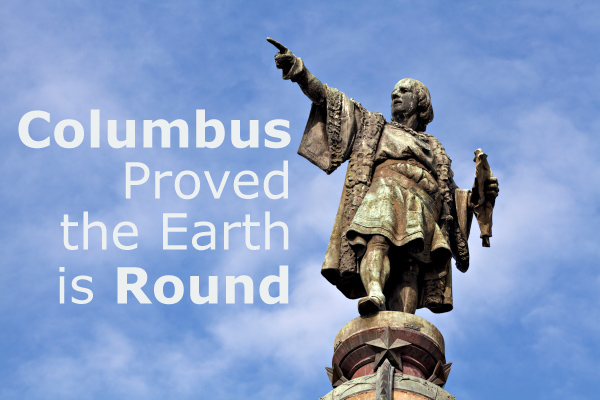Did Columbus prove the Earth is round?
Children are still taught that Christopher Columbus set sail in 1492 in order to prove that the Earth was round, not flat. The truth about Columbus and his famous voyage is far different from the myth.
Earth was first proposed to be spherical by the ancient Greeks in the 6th Century B.C., and proven three centuries later via astronomical experiments. From this time, through the Middle Ages and beyond, virtually all educated persons accepted that the Earth was a sphere, not a flat disc. In fact, navigational methods used during the time of Columbus were based on the very concept of a spherical Earth!
Columbus was not trying to prove that the Earth was round, but was actually seeking a faster trade route to the Far East, by sailing west. Because he vastly underestimated this distance, Columbus and his crew would have in fact died of hunger/thirst if they had not encountered the Americas.
Columbus departed from Palos de la Frontera, Spain on August 3, 1492 with three ships, the Santa Maria, Pinta and Nina. After restocking provisions in the Canary Islands, land was sighted five weeks later, on October 12 (celebrated in the United States as “Columbus Day” on the second Monday in October). Though Columbus landed in what is now the Bahamas, Columbus insisted they had actually reached in the East Indies, calling the inhabitants “Indios” (Indians).
Columbus would eventually make four voyages to this new world, exploring such lands as Cuba, Haiti, Puerto Rico, Jamaica, the Virgin Islands and the Dominican Republic (but not the United States!)
Historical accounts of Columbus contradict his common portrayal as a romanticized historical figure. Besides his significant navigational blunders and miscalculations, he is said to have stolen credit for being the first to sight land from crewman Rodrigo de Triana. Furthermore, he was replaced (and arrested) soon after being appointed Viceroy and Governor of the Indies by the Spanish government, due to his brutal and tyrannical rule of the native people. Columbus enslaved thousands, while his soldiers killed thousands more. More than half of Haiti’s population perished in just two years of Columbus’ governorship.
The myths surrounding Columbus apparently originated from a fictionalized work published in 1828 by Washington Irving, “A History of the Life and Voyages of Christopher Columbus.” This book was widely mistaken for a scholarly reference, its embellished and inaccurate accounts eventually working their way into the public consciousness.




